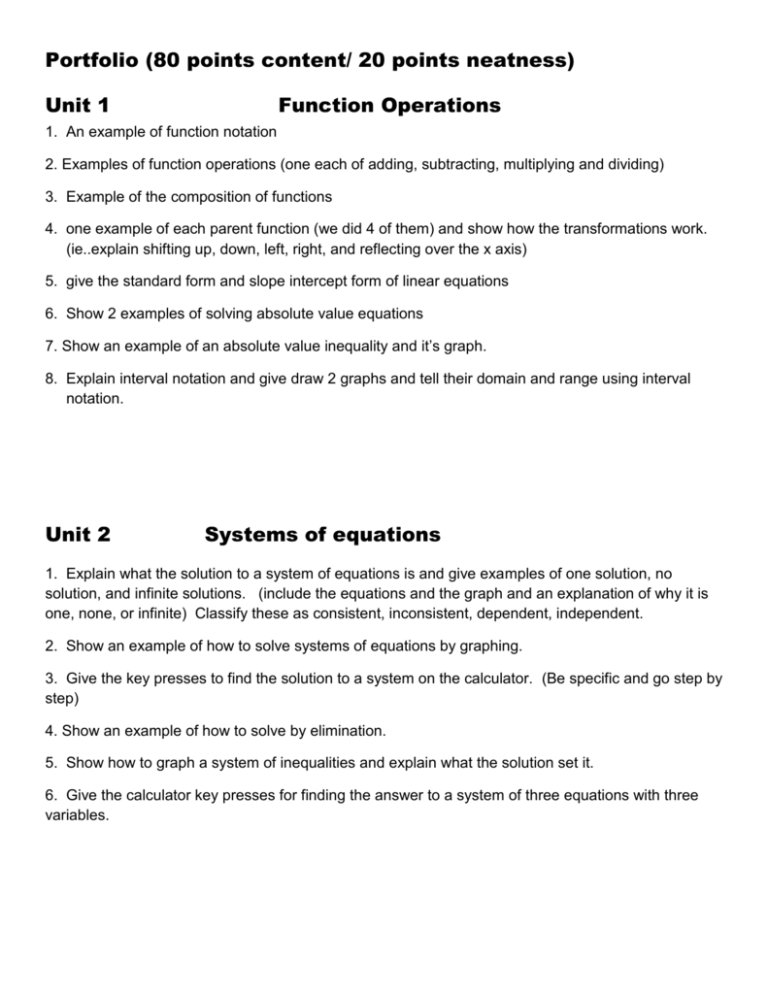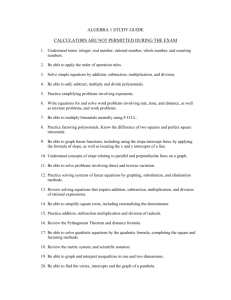Unit 7 Rational Functions
advertisement

Portfolio (80 points content/ 20 points neatness) Unit 1 Function Operations 1. An example of function notation 2. Examples of function operations (one each of adding, subtracting, multiplying and dividing) 3. Example of the composition of functions 4. one example of each parent function (we did 4 of them) and show how the transformations work. (ie..explain shifting up, down, left, right, and reflecting over the x axis) 5. give the standard form and slope intercept form of linear equations 6. Show 2 examples of solving absolute value equations 7. Show an example of an absolute value inequality and it’s graph. 8. Explain interval notation and give draw 2 graphs and tell their domain and range using interval notation. Unit 2 Systems of equations 1. Explain what the solution to a system of equations is and give examples of one solution, no solution, and infinite solutions. (include the equations and the graph and an explanation of why it is one, none, or infinite) Classify these as consistent, inconsistent, dependent, independent. 2. Show an example of how to solve systems of equations by graphing. 3. Give the key presses to find the solution to a system on the calculator. (Be specific and go step by step) 4. Show an example of how to solve by elimination. 5. Show how to graph a system of inequalities and explain what the solution set it. 6. Give the calculator key presses for finding the answer to a system of three equations with three variables. Unit 3 Exponents and Radicals 1. List the 5 exponent laws and give 5 examples. Also show zero and negative exponents. 2. Explain what a rational exponent is and give two examples. 3. Explain simplifying a radical and give an example (with a number and 2 variables). 4. Explain rationalizing the denominator. Give 2 examples: one with a monomial in the denominator and one with a binomial that requires using the conjugate to rationalize. 5. One example each of add, subtract, multiply and divide radicals. 6. 2 examples of solving radical equations. One example where there is only one radical and one example of a radical on each side of the equal sign. 7. Explain factoring quadratic, difference of 2 squares, factor by grouping, and sum/difference of cubes. 8. Write the steps and give an example of solve by factoring. (2 column note form). Unit 4 Quadratics 1. Write and label the vertex form and the standard form of quadratic equations. 2. Give a quadratic equation, show its graph and label the vertex, line of symmetry, maximum or minimum on the graph 3. Tell the domain and range of the graph in #2. Tell the intervals that are increasing and decreasing. 4. Give the calculator steps to finding the vertex. 5. Give the calculator steps for finding the zeroes. 6. Give the steps for completing the square and show an example. (2 column note format) 7. Define an imaginary number and tell what “i” through “i4” equal. 8. Give one example each of adding, subtracting, multiplying, and dividing imaginary numbers. 9. Write the quadratic formula 10. Give an example and list the steps (2 column notes) for solve by factoring, solve by completing the square, and solve using the quadratic formula. Unit 5 Polynomials 1. Show an example of each… Add, subtract, and multiply polynomials 2. Show 2 examples of long division of polynomials. One that divides evenly and one with a remainder. 3. Give an example of a quadratic, cubic, quartic, and quintic equation and graph them. 4. Tell the relative max/mins, zeros, intervals of increasing and decreasing, domain and range, and end behavior for each graph in #3. 5. Tell how to find the maximum number of turns and state the maximum number of turns for each graph in #3. 6. Give the definition of the rational root theorem and an example 7. Explain the complex conjugate theorem. Give an example 8. Give an example of synthetic division and write the steps in words. (2 column note format) . Unit 6 exponential functions and log functions 1. Graph parent functions for exponential growth and decay. Write the equations for each and label them growth and decay. 2. Write the steps and show 2 examples of solving exponential equations with like bases. (2 column note format) 3. Graph the parent function for a logarithm. Write the equation for the parent function. 4. Give one example of a word problem involving exponentials. 5. Give one example of changing from an exponential to a log and one example of changing from a log to an exponential. 6. List the properties of logs. 7. Give one example of expanding a log and one example of rewriting as a single log. 8. Give 4 examples of different log equations. 9. Write the Formulas – compound interest, Continuous compounding, growth and decay – with variables defined. Unit 7 Rational Functions 1. Definition of a rational function and give an example. 2. One example of simplifying a rational expression with the steps in 2 column note format 3. One example of multiplying rational expressions 4. 1 ea example add and subtract rational expressions with like denominators 5. 1 ea example add and subtract rational expressions with unlike denominators 6. 1 example of a complex rational expression simplified 7. 2 examples of solving rational equations Unit 8 Sequences and Series 1. Write the formula for finding the nth term of Arithmetic Sequences with an example. 2. Write the formula for finding the sum of Arithmetic series with 2 examples. One of your examples must include summation notation, ∑. 3. Write the formula for finding the nth term of a geometric sequence with an example. 4. Write the formula for finding the sum of a geometric series with 2 examples. One example must use summation notation, ∑. 5. Define recursive and explicit formulas. 6. What is Fibonacci’s sequence? Write the first 15 terms. Unit 9 Trig Turn in your unit circle on the blue paper.









